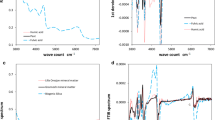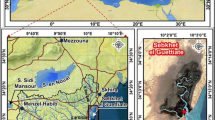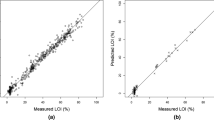Abstract
We present an independent calibration model for the determination of biogenic silica (BSi) in sediments, developed from analysis of synthetic sediment mixtures and application of Fourier transform infrared spectroscopy (FTIRS) and partial least squares regression (PLSR) modeling. In contrast to current FTIRS applications for quantifying BSi, this new calibration is independent from conventional wet-chemical techniques and their associated measurement uncertainties. This approach also removes the need for developing internal calibrations between the two methods for individual sediments records. For the independent calibration, we produced six series of different synthetic sediment mixtures using two purified diatom extracts, with one extract mixed with quartz sand, calcite, 60/40 quartz/calcite and two different natural sediments, and a second extract mixed with one of the natural sediments. A total of 306 samples—51 samples per series—yielded BSi contents ranging from 0 to 100 %. The resulting PLSR calibration model between the FTIR spectral information and the defined BSi concentration of the synthetic sediment mixtures exhibits a strong cross-validated correlation (\( {\text{R}}^{ 2}_{\text{cv}} \) = 0.97) and a low root-mean square error of cross-validation (RMSECV = 4.7 %). Application of the independent calibration to natural lacustrine and marine sediments yields robust BSi reconstructions. At present, the synthetic mixtures do not include the variation in organic matter that occurs in natural samples, which may explain the somewhat lower prediction accuracy of the calibration model for organic-rich samples.







Similar content being viewed by others
References
Bertaux J, Fröhlich F, Ildefonse P (1998) Multicomponent analysis of FTIR spectra: quantification of amorphous and crystallized mineral phases in synthetic and natural sediments. J Sediment Res 68:440–447
Bigler C, Hall RI (2002) Diatoms as indicators of climatic and limnological change in Swedish Lapland: a 100-lake calibration set and its validation for paleoecological reconstructions. J Paleolimnol 27:97–115
Brigham-Grette J, Melles M, Minyuk P, Andreev A, Tarasov P, DeConto R, Koenig S, Nowaczyk N, Wennrich V, Rosén P, Haltia E, Cook T, Gebhardt C, Meyer-Jacob C, Snyder J, Herzschuh U (2013) Pliocene warmth, polar amplification, and stepped Pleistocene cooling recorded in NE Arctic Russia. Science 340:1421–1427
Chester R, Elderfield H (1968) The infrared determination of opal in siliceous deep-sea sediments. Geochim Cosmochim Ac 32:1128–1140
Conley DJ (1998) An interlaboratory comparison for the measurement of biogenic silica in sediments. Mar Chem 63:39–48
Conley DJ, Schelske CL (2001) Biogenic silica. In: Smol JP, Birks HJB, Last WM (eds) Tracking environmental change using lake sediments, vol 3., Terrestrial, algal, and siliceous indicatorsKluwer Acad, Dordrecht, pp 281–293
Cunningham L, Vogel H, Nowaczyk N, Wennrich V, Juschus O, Persson P, Rosén P (2013a) Climatic variability during the last interglacial inferred from geochemical proxies in the Lake El’gygytgyn sediment record. Palaeogeogr Palaeoclimatol Palaeoecol 386:408–414
Cunningham L, Vogel H, Wennrich V, Juschus O, Nowaczyk N, Rosén P (2013b) Amplified bioproductivity during Transition IV (332 000–342 000 yr ago): evidence from the geochemical record of Lake El’gygytgyn. Clim Past 9:679–686
Gendron-Badou A, Coradin T, Maquet J, Fröhlich F, Livage J (2003) Spectroscopic characterization of biogenic silica. J Non Cryst Solids 316:331–337
Hahn A, Kliem P, Ohlendorf C, Zolitschka B, Rosén P, The PASADO Science Team (2012) Climate induced changes as registered in inorganic and organic sediment components from Laguna Potrok Aike (Argentina) during the past 51 ka. Quat Sci Rev 71:154–166
Hlavay J, Jonas K, Elek S, Inczedy J (1978) Characterization of particle size and crystallinity of certain minerals by IR spectrophotometry and other instrumental methods—II. Investigations on quartz and feldspar. Clays Clay Miner 26:139–143
Huang CK, Kerr PF (1960) Infrared study of the carbonate minerals. Am Miner 45:311–324
Hüneke H, Mulder T (eds) (2011) Deep-sea sediments, developments in sedimentology, vol 63. Elsevier, Amsterdam
Kamatani A, Oku O (2000) Measuring biogenic silica in marine sediments. Mar Chem 68:219–229
Madejová J, Komadel P (2001) Baseline studies of the clay minerals society source clays: infrared methods. Clays Clay Miner 49:410–432
Meyer-Jacob C, Vogel H, Gebhardt AC, Wennrich V, Melles M, Rosén P (2014) Biogeochemical variability during the past 3.6 million years recorded by FTIR spectroscopy in the sediment record of Lake El’gygytgyn, Far East Russian Arctic. Clim Past 10:209–220
Moenke HHW (1974) Vibrational spectra and the crystal-chemical classification of minerals. In: Farmer VC (ed) The infrared spectra of minerals, Mineralogical Society Monograph 4. Adlard & Son, Dorking, Surrey, pp 111–118
Ohlendorf C, Sturm M (2008) A modified method for biogenic silica determination. J Paleolimnol 39:137–142
Patwardhan SV, Maheshwari R, Mukherjee N, Kiick KL, Clarson SJ (2006) Conformation and assembly of polypeptide scaffolds in templating the synthesis of silica: an example of a polylysine macromolecular “switch”. Biomacromolecules 7:491–497
Pironon J, Pelletier M, de Donato P, Mosser-Ruck R (2003) Characterization of smectite and illite by FTIR spectroscopy of interlayer NH4 + cations. Clay Miner 38:201–211
Ragueneau O, Tréguer P, Leynaert A, Anderson RF, Brzezinski MA, DeMaster DJ, Dugdale RC, Dymond J, Fischer G, François R, Heinze C, Maier-Reimer E, Martin-Jézéquel V, Nelson DM, Quéguiner B (2000) A review of the Si cycle in the modem ocean: recent progress and missing gaps in the application of biogenic opal as a paleoproductivity proxy. Glob Planet Change 26:317–365
Rosén P, Vogel H, Cunningham L, Reuss N, Conley DJ, Persson P (2010) Fourier transform infrared spectroscopy, a new method for rapid determination of total organic and inorganic carbon and biogenic silica concentration in lake sediments. J Paleolimnol 43:247–259
Rosén P, Vogel H, Cunningham L, Hahn A, Hausmann S, Pienitz R, Zolitschka B, Wagner B, Persson P (2011) Universally applicable model for the quantitative determination of lake sediment composition using Fourier transform infrared spectroscopy. Environ Sci Technol 45:8858–8865
Rydberg J, Rosén P, Lambertsson L, De Vleeschouwer F, Tomasdotter S, Bindler R (2012) Assessment of the spatial distributions of total- and methyl-mercury and their relationship to sediment geochemistry from a whole-lake perspective. J Geophys Res Biogeo 117:1–13
Schmidt M, Botz R, Rickert D, Bohrmann G, Hall SR, Mann S (2001) Oxygen isotopes of marine diatoms and relations to opal-A maturation. Geochim Cosmochim Ac 65:201–211
Snyder JA, Cherepanova MV, Bryan A (2013) Dynamic diatom response to changing climate 0–1.2 Ma at Lake El’gygytgyn, Far East Russian Arctic. Clim Past 9:1309–1319
Sprenk D, Weber ME, Kuhn G, Rosén P, Frank M, Molina-Kescher M, Liebetrau V, Röhling H-G (2013) Southern Ocean bioproductivity during the last glacial cycle—new detection method and decadal-scale insight from the Scotia Sea. Geol Soc Lond Spec Publ 381:245–261
Street-Perrott FA, Barker PA (2008) Biogenic silica: a neglected component of the coupled global continental biogeochemical cycles of carbon and silicon. Earth Surf Proc Land 33:1436–1457
Vogel H, Rosén P, Wagner B, Melles M, Persson P (2008) Fourier transform infrared spectroscopy, a new cost-effective tool for quantitative analysis of biogeochemical properties in long sediment records. J Paleolimnol 40:689–702
Vogel H, Wagner B, Zanchetta G, Sulpizio R, Rosén P (2010) A paleoclimate record with tephrochronological age control for the last glacial-interglacial cycle from Lake Ohrid, Albania and Macedonia. J Paleolimnol 44:295–310
Vogel H, Meyer-Jacob C, Melles M, Brigham-Grette J, Andreev AA, Wennrich V, Tarasov PE, Rosén P (2013) Detailed insight into Arctic climatic variability during MIS 11c at Lake El’gygytgyn, NE Russia. Clim Past 9:1467–1479
Weber ME, Kuhn G, Sprenk D, Rolf C, Ohlwein C, Ricken W (2012) Dust transport from Patagonia to Antarctica—a new stratigraphic approach from the Scotia Sea and its implications for the last glacial cycle. Quaternary Sci Rev 36:177–188
Wold S, Sjöström M, Eriksson L (2001) PLS-regression: a basic tool of chemometrics. Chemometr Intell Lab 58:109–130
Acknowledgments
Funding for the FTIRS research was provided by the Swedish Research Council (VR), FORMAS, and the Kempe Foundation. We are grateful to N. Mantke for assistance during the preparation of pure diatom extracts, Daniela Sprenk for assisting with the FTIRS measurement of samples from the Scotia Sea, as well as J. Karls and V. Wennrich for providing diatom-rich sediments from Lake Yoa and Kieselgur Grube Klieken. We thank two anonymous reviewers for their comments and suggestions, which helped improve this manuscript.
Author information
Authors and Affiliations
Corresponding author
Rights and permissions
About this article
Cite this article
Meyer-Jacob, C., Vogel, H., Boxberg, F. et al. Independent measurement of biogenic silica in sediments by FTIR spectroscopy and PLS regression. J Paleolimnol 52, 245–255 (2014). https://doi.org/10.1007/s10933-014-9791-5
Received:
Accepted:
Published:
Issue Date:
DOI: https://doi.org/10.1007/s10933-014-9791-5




